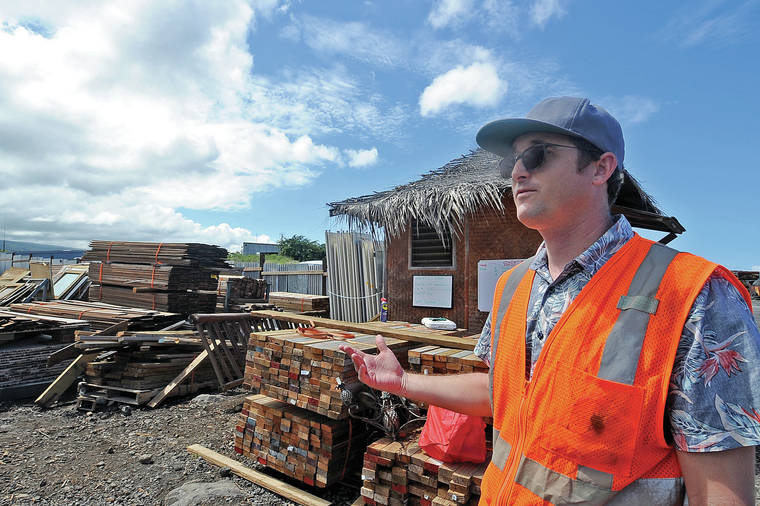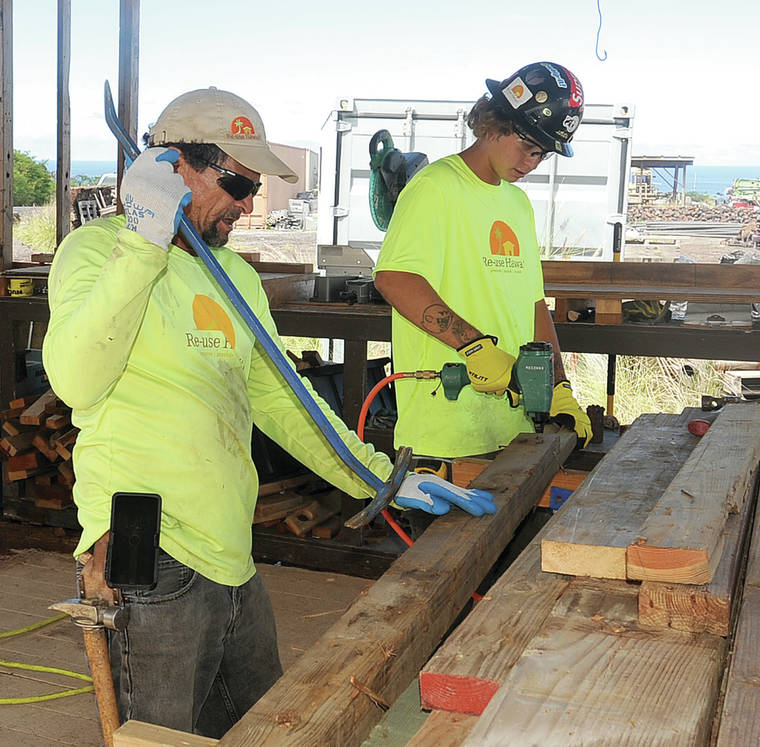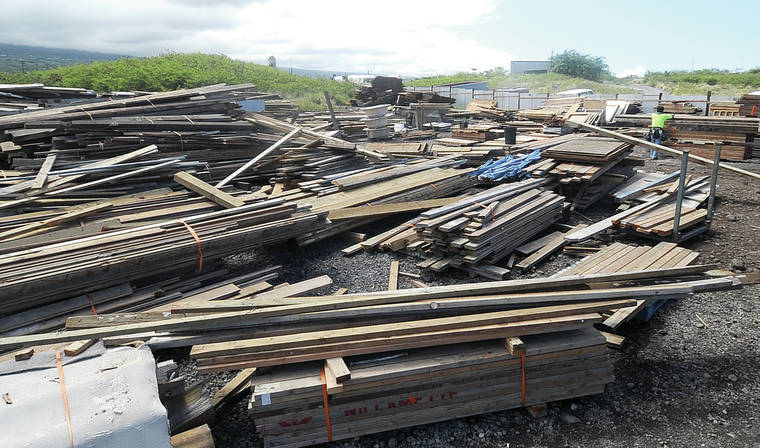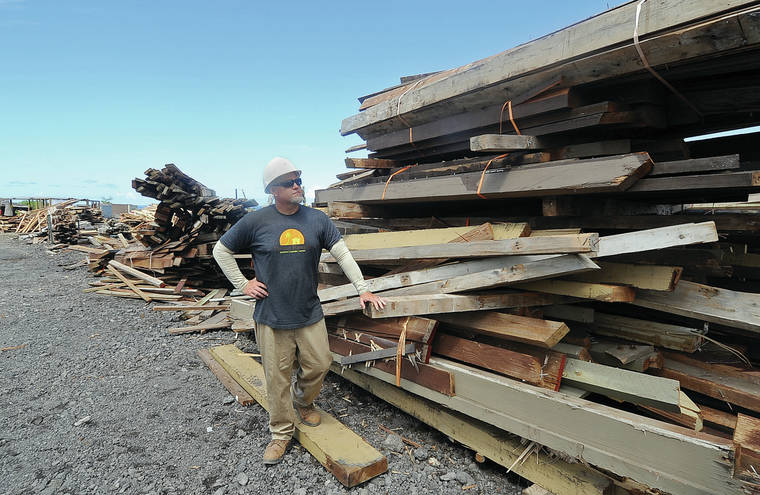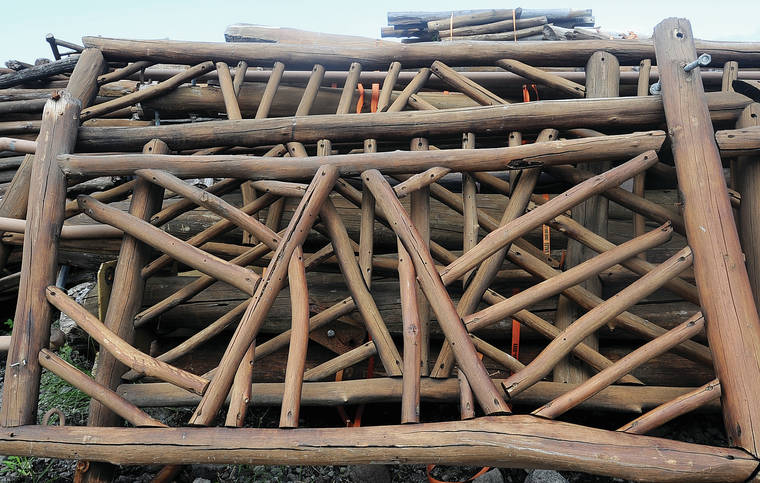KAILUA-KONA — The term “recycling” invokes images of sorting aluminum soda cans, tubs stacked with glass mason jars or bins full of plastic grocery bags, but re-usable material often comes on a far greater scale.
One company on Hawaii Island has assumed a more macro view of recycling and in only a year has filled an entire baseyard with salvaged material from demolished structures. Re-use Hawaii is a nonprofit deconstruction business, and the only one of its kind, focused on reducing the single largest landfill waste stream in the state.
“In Hawaii, 30% of waste comes from construction and demolition material, and a lot of it is actually re-usable,” said Quinn Vittum, the company’s chief operating officer. “We’re also generating an affordable community resource from that, so it’s kind of a no-brainer.”
Vittum expanded Re-use Hawaii, which began on Oahu in 2006, to West Hawaii last year. Thus far, the eight-person Hawaii Island team has spent the majority of its time and effort surgically dismantling Kona Village Resort, which was ravaged by a tsunami that slammed into leeward shores in 2011.
The company will also begin conducting select-site deconstruction on portions of the Canoe House at the Mauna Lani Bay Hotel and Bungalows.
“We look at how a building was built and do it in reverse, where as standard demolition is to roll in with a machine and crunch the building,” Vittum said.
The process begins with the removal of non-structural materials like copper or wiring. Next to go is drywall and carpet. Then Re-use Hawaii begins stripping lumber and other usable materials from the roof down.
It’s meticulous, said Kona Redistribution Center Manager Damian Bilardo, but there’s value in the process for each party involved.
“The objective is saving as much from going into that landfill as possible,” Bilardo continued. “Whatever we can salvage we want to provide to the public. We try to make that as clean and processed and plentiful for everyone.”
End users, or customers who buy the recycled material, tend to be do-it-yourself homeowners or general contractors.
Famous Hawaiian singer/songwriter Jack Johnson recently purchased pieces of California redwood taken from Kona Village Resort to use as siding on a home he’s building on Oahu. Those trees are now protected and no longer cut down for use as lumber — one example of the value that can be found in secondhand building materials.
Re-use Hawaii sells lumber, such as ohia posts, for about half the price it would demand at retail. Other items like ceramic roofing can go for as little as 10 cents on the dollar. All are subjected to a thorough, two-step quality control inspection, Vittum said.
The team at the redistribution site can run checks for potential customers regarding what the baseyard has in stock, as well as help advise novices on what they might need for their specific projects.
For the owner of the deconstructed building, savings come in the form of tax deductions, as Re-use Hawaii operates as a nonprofit.
“On a lot of these projects it’s like tens of thousands of dollars in tax deductions, so it actually pays to go the deconstruction route,” Vittum said.
Benefits to the environment are evident, as more than 600,000 tons of waste in Hawaii are attributed directly to construction debris. Vittum said roughly 70 percent of materials from a private residence can be salvaged. There are 450 homes demolished on Oahu annually, he added, and 70 homes were demolished on Hawaii Island in 2017.
Contractors hired for deconstruction projects also find value in outfits like Re-use Hawaii. Kevin McClure, of Dowbuilt, has contracted the company for a project at Kukio and plans to use its services again at Hualalai.
Re-use Hawaii allows for teams already on site to either focus efforts elsewhere or speed up the deconstruction process by working in concert. This equates to labor and schedule savings, McClure said.
He added that the waste situation on Hawaii Island, namely the soon-to-come closure of the landfill in Hilo, renders deconstruction services even more viable.
“I think it’s pretty relevant for us in West Hawaii as we’re looking at so much East Hawaii trash getting trucked over here,” he said. “Re-use should cover the island.”
Vittum said the West Hawaii baseyard could eventually grow enough to cover the entire island. He’s also considered expansion to both Maui and Kauai. His company already employs 35 people on Oahu and tends to tackle three or four projects there simultaneously.
However, as a nonprofit, Re-use Hawaii generates roughly 10 percent of its annual budget from outside sources. That includes support from local foundations and funds from the state grant-in-aid program, which Vittum said was crucial to the company’s expansion to Hawaii Island.
Rep. Nicole Lowen (D-Kona) said Re-use Hawaii received $200,000 from the Legislature in 2018, partially to fund expansion.
“Obviously we have a landfill problem,” she said. “Also, it can be a workforce development initiative because creating this re-use market where we’re training people to do the reconstruction, it’s a whole new industry that employs people and it’s a benefit to the state.”
The Re-use Hawaii baseyard is located across from West Hawaii Concrete and below Soil Plus on Allied Quarry Road. It can be accessed by taking the last right turn off Queen Kaahumanu Highway before Hina Lani Street.
Info: www.reusehawaii.org or by contacting Bilardo at (808)-208-3757.







